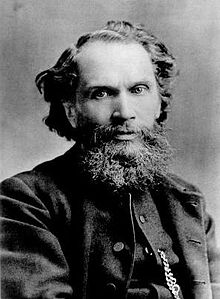Benjamin Waugh
This article needs additional citations for verification. (April 2016) |
Benjamin Waugh | |
|---|---|
 Waugh c. 1900 | |
| Born | 20 February 1839 |
| Died | 11 March 1908 (aged 69) Westcliff, Essex |
| Nationality | English |
| Education | Theological college, Bradford |
| Occupation | Minister |
| Religion | Congregationalist |
Benjamin Waugh (20 February 1839 – 11 March 1908) was a Victorian social reformer and campaigner who founded the UK charity, the National Society for the Prevention of Cruelty to Children (NSPCC) in the late 19th century, and also wrote various hymns.[1]
Early life
Waugh was born, the son of a saddler, in Settle, West Riding of Yorkshire. Aged eight, he was deeply affected by the death of his mother and soon afterwards his father sent him to a small private school in Warwickshire run by his maternal uncle, a Congregationalist minister. When 14, he was apprenticed to Samuel Boothroyd, a prosperous draper and leading member of the Congregational Church in Southport, Lancashire. By the age of 20, Waugh had become secretary of the local branch of the United Kingdom Alliance, a leading temperance organisation. His religious commitment led to him giving up the drapery business while remaining friendly with his former employer whose daughter Sarah was to become his wife. Between 1862 and 1865, he studied at the Congregationalist Airdale Theological College in Bradford and on graduation, married Sarah Boothroyd with whom he moved to Newbury, near Reading, as minister to the local Congregational church. Both politically liberal and a non-fundamentalist, he became a Fellow of the Geological Society in 1865. A year later, he accepted the pastorate of the Independent Chapel at Maze Hill in Greenwich.
Early Career
As a Congregationalist minister in poverty-stricken East Greenwich, Waugh devoted himself to improving the conditions of the inhabitants, including establishing a creche for working mothers and a Society for Temporary Relief in Poverty and Sickness. In 1870, John Stuart Mill and four trade unions nominated him as a candidate to represent Greenwich to London’s new School Board where when after his successful election ed he was to argue for non-sectarian elementary education. Making friends with fellow Board member, Thomas Huxley, he learnt from the importance of factual investigation in his subsequent campaigns on behalf of neglected children.[i] The first of these concerned the incarceration of child offenders in adult prisons and Waugh first became widely known for his book, The Gaol Cradle, Who Rocks it? that pleaded against child imprisonment and for the creation of juvenile courts. The year following its publication he collapsed from over-work but despite thereafter declining re-election to a third three-year term on the School Board, continued to do too much.
The Sunday Magazine
After another breakdown in 1877, he resigned his ministry in Greenwich on medical advice and accepted an offer by the publisher Isbister to edit the widely-circulated monthly periodical, the Sunday Magazine. It attracted contributions from numerous well-known writers, including novelist Hesba Stratton who helped found what later became the National Society for the Prevention of Cruelty to Children. Waugh also contributed poems and articles to the magazine. His 'Sunday Evenings with the Children' were later collected and published in book form.
London Society for the Prevention of Cruelty to Children
In 1884, he was a co-founder (with Sarah Smith, Lady Burdett-Coutts, Lord Shaftesbury and others)[1] of the London Society for the Prevention of Cruelty to Children (echoing a similar initiative in Liverpool), launched at London's Mansion House on 8 July. The London body's first chairman was veteran social reformer, Earl Shaftesbury. It evolved to become the NSPCC some five years later (14 May 1889), with Waugh as its first director and Queen Victoria as its first patron.
Family and homes
With his wife Sarah Elizabeth, Waugh had twelve children including daughters Edna, who would become a notable watercolour artist and draughtsman, and Rosa, who would follow in his footsteps as a social campaigner.
Waugh lived at a number of addresses including Oak Cottage, Shipbourne in Kent, Croom's Hill in Greenwich, and at 53 Woodlands Villas (today Vanbrugh Park) in neighbouring Blackheath. In 1884 he was living at 33 The Green, Southgate.[2] He later retired, in 1905, to live at 4 Runwell Terrace in Westcliff,[3] a suburb of Southend, Essex, where he died three years later, and was buried in the Southend borough cemetery.[1]
A blue plaque marks a property mistakenly believed to be that of Waugh's residence on Croom's Hill when it was installed in 1984 by the Greater London Council. English Heritage, the successor authority responsible for blue plaques correctly identifies Waugh's former home as 62 Croom's Hill.[4]
Gallery
-
Waugh's blue plaque at Croom's Hill, Greenwich
-
The plaque to Benjamin Waugh at 33 The Green.
-
Benjamin Waugh with some of his family of twelve children in about 1889.
References
- ^ a b c Lee, Sidney, ed. (1912). . Dictionary of National Biography (2nd supplement). London: Smith, Elder & Co.
- ^ a b "A Walk in Southgate".
- ^ "Benjamin Waugh". Bygone Southend. Retrieved 24 March 2017.
- ^ "English Heritage". www.english-heritage.org.uk. Retrieved 24 March 2017.
External links
- 1839 births
- 1908 deaths
- People from Settle, North Yorkshire
- English Christian religious leaders
- English Congregationalists
- English philanthropists
- Members of the London School Board
- British reformers
- British social reformers
- National Society for the Prevention of Cruelty to Children people
- 19th-century British philanthropists
- Burials in Essex


![Benjamin Waugh's home once stood on this site at 33 The Green, Southgate.[2]](http://upload.wikimedia.org/wikipedia/commons/thumb/a/ad/33_The_Green%2C_Southgate.JPG/90px-33_The_Green%2C_Southgate.JPG)

